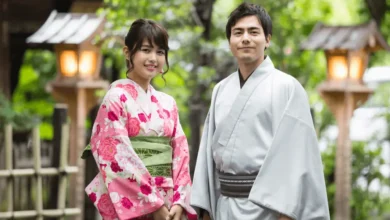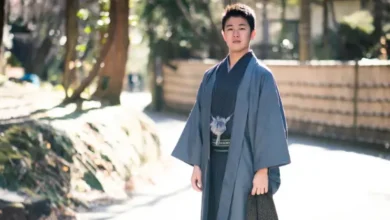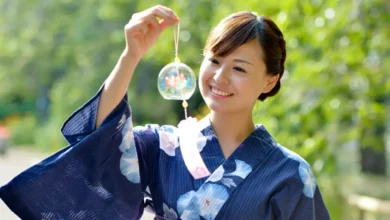The kimono is one of the most iconic garments in Japanese culture. For centuries, it has been worn by individuals across Japan, symbolizing tradition, beauty, and a deep connection to the country’s history.
Although modern Japan has evolved, the kimono remains a cherished symbol of cultural heritage and is still worn for special occasions such as weddings, tea ceremonies, and festivals. In this article, we will explore the kimono in depth, from its historical significance to its various styles and modern-day uses.
What is a Kimono?
The kimono is a traditional Japanese robe characterized by long sleeves, a wrap-around design, and a wide belt called an obi. The garment is typically made from silk, though it can also be crafted from cotton, wool, and other materials depending on the season and occasion. The kimono is worn with a variety of accessories, including a haneri (collar), obijime (decorative cord), and obidome (ornamental clip), which all enhance its aesthetic appeal.
History of the Kimono

The history of the kimono dates back over a thousand years, evolving through different periods in Japan’s history. Initially, it was influenced by Chinese and Korean clothing styles, but over time, it became distinctly Japanese. During the Heian period (794-1185), the kimono was known for its elaborate designs and long sleeves, and it was worn by the aristocracy. The samurai class and common people had different variations of the kimono, reflecting their social status.
See also Traditional Vietnam Clothing: Áo Dài
Traditional Vietnam Clothing: Áo Dài
In the Edo period (1603-1868), the kimono became widely popular among all classes. With advancements in dyeing and weaving techniques, the variety of fabrics and designs expanded, and kimonos began to feature intricate patterns, representing not only the wearer’s status but also the season or occasion. Today, the kimono is associated with ceremonial events, but it continues to hold a special place in Japanese culture.
Different Types of Kimonos

There are several types of kimonos, each with specific uses, fabrics, and designs suited to various occasions. Here are some of the most notable types:
- Furisode: A kimono with long, flowing sleeves, typically worn by young, unmarried women. It is often seen at weddings or New Year’s celebrations.
- Tomesode: A formal kimono worn by married women, often at weddings and other significant events. It features shorter sleeves than the furisode.
- Houmongi: A semi-formal kimono that can be worn by both married and unmarried women. It often features elegant designs.
- Yukata: A casual, lightweight kimono typically worn in the summer or during festivals. Unlike traditional kimonos, it is made from cotton and is worn without an obi.
- Kurotomesode: A black kimono worn by married women, often for formal ceremonies like weddings or tea ceremonies. The design is usually minimalistic with colorful patterns at the hem.
- Iromuji: A solid-colored kimono worn for tea ceremonies or formal gatherings. It is typically paired with a plain obi.
The Structure of a Kimono
A traditional kimono is made of several components, each contributing to its overall aesthetic. The most essential parts include:
Kimono Body
The body of the kimono is composed of several panels of fabric that are sewn together. These panels are shaped to fit the body and create the distinct “T” shape that is characteristic of the kimono. The back and front panels are often adorned with patterns or designs that have specific meanings, such as flowers for spring or cranes for longevity.
See also Traditional Indian Clothing: A Vibrant Tapestry of Culture and Style
Traditional Indian Clothing: A Vibrant Tapestry of Culture and Style
Obi (Belt)
The obi is a wide belt tied around the waist to secure the kimono. It is typically made from a stiffer material to provide structure to the garment. The way the obi is tied varies depending on the occasion and the wearer’s gender. Women’s obi are often tied in elaborate knots at the back, while men’s obi are tied more simply at the front or side.
Obijime and Obidome
To further enhance the kimono’s appearance, accessories like the obijime (decorative cord) and obidome (ornamental clip) are added. The obijime holds the obi in place, while the obidome serves as a decorative piece, often made from jade, coral, or other materials. These accessories can be personalized to suit the wearer’s style or the season.
How to Wear a Kimono
Wearing a kimono is an intricate process that requires attention to detail. Here’s a basic overview of how to wear a kimono:
- Put on the Underwear: A basic undergarment called a “juban” is worn underneath the kimono. It is usually made from cotton or silk and helps protect the kimono from sweat and oils from the skin.
- Wear the Kimono: The kimono is draped over the shoulders and wrapped around the body. The left side of the kimono should always be over the right side, except in the case of dressing the deceased.
- Secure the Kimono: The kimono is held in place with an obi, which is wrapped around the waist and tied in a decorative knot at the back.
- Add Accessories: The final touches include the obijime, obidome, and haneri (collar). These elements complete the ensemble and add to the overall elegance of the kimono.
Kimono Fabric and Patterns
The kimono fabric is often a key indicator of the garment’s formality and seasonality. The materials and patterns used in the kimono can vary greatly depending on the time of year and the occasion. Common fabrics include:
- Silk: The most traditional and luxurious fabric for kimonos, silk is used for formal occasions and weddings.
- Cotton: Often used for summer kimonos or yukata, cotton is lighter and more breathable.
- Wool: Worn in colder months, wool kimonos are typically used for less formal occasions.
In terms of patterns, the designs on a kimono can carry symbolic meanings. Floral patterns, such as chrysanthemums and peonies, are common and represent beauty, while cranes and tortoises are symbols of longevity and good fortune.
Kimono Etiquette and Cultural Significance
In Japan, wearing a kimono is a ceremonial act, and there are specific rules of etiquette associated with the garment. For example, the way one ties the obi or the direction the collar faces can indicate the formality of the occasion. The kimono is also a symbol of respect for tradition and culture, and wearing it at festivals, weddings, and other events is a way to honor these customs.
Kimono for Weddings
Weddings in Japan are among the most significant occasions where the kimono is worn. Brides typically wear a white kimono, known as a shiromuku, symbolizing purity. The groom often wears a black hakama with a haori jacket, which complements the bride’s attire. The wedding ceremony is a reflection of the couple’s respect for tradition and their families.
Kimono in Festivals
Festivals like the Gion Matsuri in Kyoto or the Aoi Matsuri feature participants in traditional kimonos, showcasing the cultural importance of the garment. During the summer months, people wear yukatas to outdoor festivals, enjoying fireworks and festivities.
Modern-Day Use of Kimono
While the kimono is not an everyday garment in modern Japan, it continues to play an essential role in special events and ceremonies. Many young people now wear kimonos for their coming-of-age ceremony, called “Seijin Shiki,” and it is also common to see kimonos worn at tea ceremonies, funerals, and other significant cultural events.
Kimono as a Fashion Statement
In recent years, the kimono has made its way into the global fashion scene. Many fashion designers incorporate kimono elements into modern clothing, blending traditional styles with contemporary aesthetics. These modern kimonos are often shorter and made from more comfortable materials, making them more accessible for everyday wear while still retaining a nod to Japan’s rich cultural heritage.
Challenges in Maintaining the Tradition of Kimono Wearing
As Japan becomes increasingly modernized, the traditional practice of wearing the kimono has faced challenges. The complexity of wearing a kimono and the time it takes to prepare make it difficult for many people, especially the younger generation, to embrace it as part of daily life. However, cultural institutions and fashion designers continue to work towards keeping the kimono tradition alive, encouraging people to wear it for significant occasions and educating future generations about its cultural importance.
Final Thoughts on the Kimono
The kimono is far more than just a garment; it is a cultural symbol that embodies Japan’s rich history, aesthetics, and values. Though it is no longer a part of everyday life for most people in Japan, its significance in ceremonial contexts remains strong. The intricate beauty of the kimono, with its delicate fabrics, vibrant patterns, and elegant accessories, continues to captivate the world and is a testament to the timeless nature of traditional Japanese clothing.


